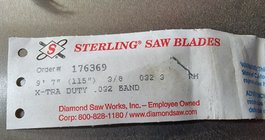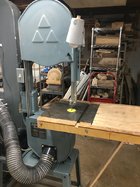First, I'm a novice turner (began in August 2023) andi purchased a Laguna 14BX bandsaw.
I blasted through several blades, first the Woodturners 115" 0.032 from Highland, then a Carter green wood, then another Woodturners, then a Timberwolf 1/2" and now back to Woodturners from Highland. I am assuming user error due to wood catching and grabbing on a 3 TPI aggressive blade. They twisted and I wasnt about to mess with them.
I read practically all info on this site and read over a quoted Odie tutorial and talked to and viewed lots of Alex Snodgrass (https://bandsawlife.com/) YouTubes along with long emails with Laguna technician. In this forum I noted a lot of good comments on the bimetal Lenox blades. Carbide tipped blades are overkill for me I believe.
I purchased sleds from Carter along with their guides (I ruined the ceramic guides that Laguna uses) and I think I learned what I did wrong with the ruined blades. I am better now and have figured out guide adjustment, proper tensioning, feed rate, and stabilizing the wood for crosscuts and resawing. I am also debarking the wood to avoid dulling the blades. I still struggle with rotating a blank to create a round blank despite all the above and making a jig to allow for stable rotation of the blank.
So that is all background and the real reason I am posting and inviting responses from seasoned (excuse the pun) turners and woodworkers is what appears to be a major discrpeancy between the Highland Woodworking site's info about the Woodturners Bandsaw Blade and what the manufacturer states.
The blades I have purchased upon recommendations are the Highland Woodturners 3/8 blade. I decided to find out where they are made and went to the manuf. site https://www.diamondsaw.com/pages/products/bandSawBlades/specialty/X-TraDuty.aspx. I know that is the maker since all blades came with stapled tag (included in this post)
The manufacturer has this to say about these blades (i put the link above) "... Not recommended for machines that take a band less than 15’ in length." My bandsaw is for a 115" blade (9'7") clearly far beneath the 15' (180") recommended.
When I emailed Highland about this (wondering if this could be the reason my blades are not performing as well as others are saying) they told me I was looking at the wrong blade... "That’s for the WoodSlicer. A different manufacturer and only for 3/4” blades. Your bandsaw is ideal for 3/8”, 1/2”, and smaller blades. "
So the support team at Highlands either did not read the email I sent or bother to look at the details from the manufacturer.
I'm just trying to determine if part of my problem is that I am using a blade UNSUITABLE for the Laguan 14BX based on what the manufacturer clearly states.
Sorry for the long winded post.

I blasted through several blades, first the Woodturners 115" 0.032 from Highland, then a Carter green wood, then another Woodturners, then a Timberwolf 1/2" and now back to Woodturners from Highland. I am assuming user error due to wood catching and grabbing on a 3 TPI aggressive blade. They twisted and I wasnt about to mess with them.
I read practically all info on this site and read over a quoted Odie tutorial and talked to and viewed lots of Alex Snodgrass (https://bandsawlife.com/) YouTubes along with long emails with Laguna technician. In this forum I noted a lot of good comments on the bimetal Lenox blades. Carbide tipped blades are overkill for me I believe.
I purchased sleds from Carter along with their guides (I ruined the ceramic guides that Laguna uses) and I think I learned what I did wrong with the ruined blades. I am better now and have figured out guide adjustment, proper tensioning, feed rate, and stabilizing the wood for crosscuts and resawing. I am also debarking the wood to avoid dulling the blades. I still struggle with rotating a blank to create a round blank despite all the above and making a jig to allow for stable rotation of the blank.
So that is all background and the real reason I am posting and inviting responses from seasoned (excuse the pun) turners and woodworkers is what appears to be a major discrpeancy between the Highland Woodworking site's info about the Woodturners Bandsaw Blade and what the manufacturer states.
The blades I have purchased upon recommendations are the Highland Woodturners 3/8 blade. I decided to find out where they are made and went to the manuf. site https://www.diamondsaw.com/pages/products/bandSawBlades/specialty/X-TraDuty.aspx. I know that is the maker since all blades came with stapled tag (included in this post)
The manufacturer has this to say about these blades (i put the link above) "... Not recommended for machines that take a band less than 15’ in length." My bandsaw is for a 115" blade (9'7") clearly far beneath the 15' (180") recommended.
When I emailed Highland about this (wondering if this could be the reason my blades are not performing as well as others are saying) they told me I was looking at the wrong blade... "That’s for the WoodSlicer. A different manufacturer and only for 3/4” blades. Your bandsaw is ideal for 3/8”, 1/2”, and smaller blades. "
So the support team at Highlands either did not read the email I sent or bother to look at the details from the manufacturer.
I'm just trying to determine if part of my problem is that I am using a blade UNSUITABLE for the Laguan 14BX based on what the manufacturer clearly states.
Sorry for the long winded post.


